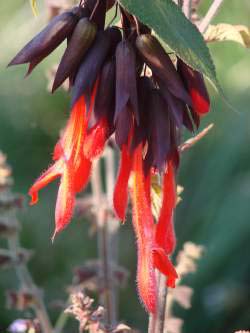Sacred Sage: Giant Bolivian Sage

Giant Bolivian Sage (Salvia dombeyi) is the big kid in the mint family (Lamiaceae). Of all Lamiaceae’s more than 6,500 species worldwide, S. dombeyi is the one with the longest blossoms and tallest growth.
Growing up to 5 inches long, each crimson Giant Bolivian flower drips dramatically from a burgundy calyx, the leaf-like sepals connecting the blossom to the plant’s stems. The plant’s bright green, heart-shaped leaves are equally long.
Hummingbird Heaven
North American hummingbirds are thrilled to encounter these deep wells of nectar even if their beaks aren't long enough to get to the bottom of the blossoms and pollinate them. In South America, the flowers are accessed by hummingbirds with equally long beaks. This is a good thing, because it ensures survival of the species. Although a Giant Bolivian Sage likely won't set seed in a U.S. garden (never say never), it will flower beautifully for many seasons if growing conditions are right.
Big But Tender
Not as tough as its size might indicate, Giant Bolivian Sage tolerates neither a hint of frost nor severe heat. It is native to the cool mountain highlands of Bolivia and Peru.
Mild temperate climates work well for this vining Salvia especially when temperatures range from 40 to 75 degrees Fahrenheit. If you live in an area where temperatures drop into the 30 degree range for more than a few days, you may need to consider growing Giant Bolivian Sage as an annual. However, if your summers are intensely hot, this is not the right plant for your garden.
Yet given the right temperatures, shade and supports -- such as walls, trellises or tall plants to creep up -- Giant Bolivian Sage will thrive and grow up to 9 feet tall in one season. In Bolivia and Peru, it sometimes reaches up to 20 feet tall. At either height, it puts on a spectacular display.
Garden writer Betsy Clebsch, who specializes in growing and writing about Salvias, notes that San Francisco’s Strybing Arboretum successfully maintains a 12-foot-tall Giant Bolivian Sage on a fence shaded by tall conifers. The trees protect the plant from wind as well as cold air. So before planting one of these beauties, survey your yard for a similarly protected position.
Growing Conditions
Giant Bolivian Sage grows best in partial shade where it receives about 40 to 50 percent indirect sunlight, preferably in the morning. Afternoon shade protects it at a time of day when sunlight is more intense. In the wild it rarely sees temperatures above the mid 80s, so take this into consideration when considering this plant for your collection.
It needs loamy, well-drained soil. Unlike most Salvias, which prefer drier conditions, Giant Bolivian Sage needs consistently moist soil. It also requires more soil amendment than most Salvias and likes liquid fertilizer, applied at half strength, twice a month.
You can expect Giant Bolivian Sage to flower from late summer through autumn. If you have a greenhouse, you may want to dig up the plant in late fall and move it to a pot for winter. A winter stay in a greenhouse not only guarantees the plant’s survival, but also its ability to flower outdoors during the next growing season.
To reach its flowering stage before first frost, Giant Bolivian Sage needs to be well rooted when first planted in spring. At FBTS we sell it 3.5-inch pots to ensure this success. We also confirm the identity of this rare species so you will know that you are getting the real thing.
Sacred Roots
Red was a sacred color in Ancient Incan culture. The red blossoms of various flowers were prized, including Giant Bolivian Sage, and were used as part of religious ceremonies that likely included human sacrifices. The blossoms and the sacrificial offerings were intended to appease various gods, including mountain dieties who the Incans believed were the cause of volcanic eruptions. As a 1971 article in The New York Times noted, S. dombeyi -- also known as sacha flucchu in the Inca Quecha language -- is "nurtured and loved" in its native Peru "for its historic and religious significance."

 Salvia dombeyi
Salvia dombeyi
Comments
There are no comments yet.